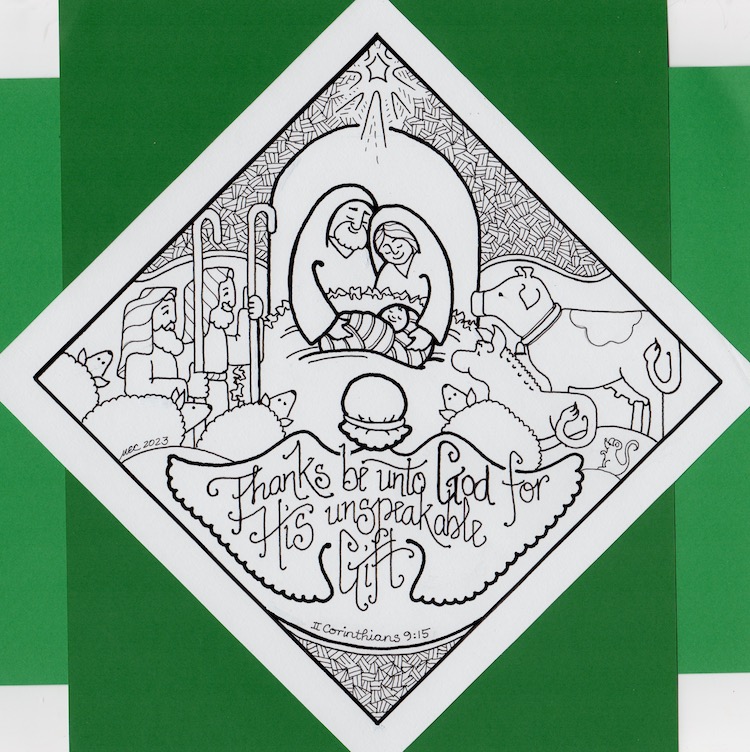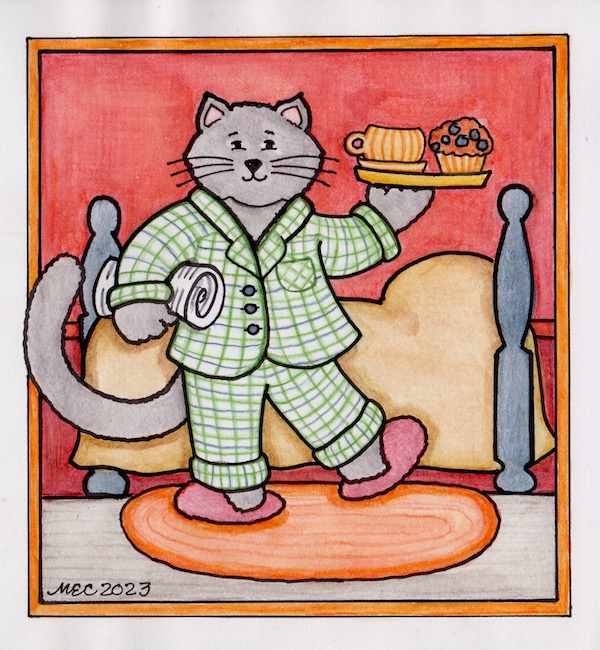What's Your Story?
(illustration of cat's pajamas. See below. ;) )
Babies know, from birth, how to recognize the human face. The arrangement of eyes, nose and mouth is installed as an imprint in our brain. Later, as we grow, we’re given another help: our brain supplements actual eyesight with knowledge of what we’re looking at, so we can navigate better than we could with just raw visual data. A yellow box appears on the horizon; our brain tells us, based on prior knowledge, it's the school bus.
I think the framework of “story” comes from the factory the same way, impressed into the soft structure of our brains as a template. We see the world in terms of story. Just as a baby needs the structure of “face” to begin to step into life, we need a structure to process the swirling events around us. Beginning, middle, end – classic story structure.
Any three facts make a story. That’s what people, the world over, do. Husband coming home late, three nights running? What’s the story? Three coughs, ditto – A head cold caught from the guy at the meat counter? Or seasonal flu? tuberculosis? Multiple visitors next door – a party? a funeral? a drug dealer? We construct stories. We can’t help it.
Well, if facial recognition helps a baby adjust to life in this world, and if the brain-supplied visual data helps us catch the bus… what good is story structure?
For one thing, it's useful. My brilliant husband, who could not be bothered to pay attention in high school, was given, as a gift, a Mensa membership application. Intrigued, he went for the test, not sure he’d pass this bar to enter The Society of The Very Smart. When he relaxed and absorbed the entry memory test as a story, he found it easy, and passed.
More than memory aid, story structure is a compass, a directional tool. We decide how to move forward based on how we see the story developing. Cause and effect is a two part structure, useful in scientific experiments, but story is a three part construct: beginning, middle, and end. With cause-and-effect, your beginning determines your outcome. But with story structure, you’re allowed a mid-point plot twist, a direction change, a chance to grow and develop. For example: 1) Beginning: The weather channel announces freezing rain at 5 pm. 2) Middle: My drive home from work. 3) End: Crash or victorious homecoming? A thoughtful driver puts the story together, makes mid-story adjustments and prayers based on the first part, thus shaping the story's end.
Our life is a story in which we are the main character, and we're constantly editing the story of our life. One week I tell myself I’m Lazy Susan, next week I’m the cat’s pajamas, then later I might come onstage as Large-Marge-Sarge-of-the-Barge. We collect incidents and turn them into stories: “I dropped it because I'm clumsy,” “I’m always late,” “I must win,” “I’m the best speller in my school,” “I cannot tell a lie,” etc. The story acts as self-fulfilling prophecy. The plot is informed by our parenting, life events, choices, but we construct the story. The same life that led us to conclude “I’m lazy” might just as easily have been shaped into “I’m a very peaceful soul.”
We think we operate based on facts and evidence, but we tend to ignore them if they upset our chosen story. To do otherwise would be like a sailor pitching his compass overboard in a storm. Life without story would be a constant storm of unconnected facts. No narrative. We wouldn’t know when to take that cough to the doctor, that cheating spouse to divorce court, that ache in our heart to church. We wouldn’t connect the dots.
A prominent podcaster tells the story of praying one of those God-if-You’re-Real prayers, asking for a call from his mom, from whom he’d not heard in years. And the phone rang. You don’t need me to tell you who it was. There are those who would say this is a story about coincidence, explaining that the world is run by luck. I repeat: we tend to ignore facts that upset our chosen story. The podcaster saw a different story in operation, and gave his life to the God Who could arrange such a thing.
The Christmas season is upon us, as I write. What a story! God’s son arrives as a baby, opposed by all the forces of the world, supported by some random shepherds, some angels, some warning dreams. Going on to spend much of His time telling stories until He is executed, and, in the ultimate plot twist, raised from the dead, the perfect answer to the world’s problems, should they choose to embrace His story, and Him.
“We see through a glass, darkly,” says the Apostle Paul in the oft-quoted thirteenth chapter of I Corinthians. Just as a baby responds to his mother’s face, not because he knows her, but because “face” is hardwired into his developing brain, our minds use the structure of “story” to wend our way through the circumstances, happenstances, and general tomfoolery of daily living. Through the darkness, we proceed by the light of the story we think we are living. Pick a good one.

I'm always thankful, and I say it every time, for your time in reading this. I try to put out thought-provoking content, albeit at irregular intervals. To subscribe to my irregular writings, click here.
And, Merry Christmas!
